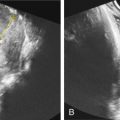Abstract
CHARGE syndrome is an autosomal dominant disorder characterized by multiple congenital malformations along with developmental and cognitive impairments. The incidence of CHARGE syndrome is 1 : 8500 to 1 : 10,000. The only known genetic etiology for CHARGE syndrome is CHD-7, which accounts for up to 65% of cases. Prenatal diagnosis can be made using ultrasound and amniocentesis for CHD-7 molecular genetic testing. Postnatal management should consist of a multidisciplinary team approach to correct structural defects and assess and treat developmental and cognitive impairments.
Keywords
CHARGE syndrome, multiple congenital malformations, CHD-7, choanal atresia
Introduction
CHARGE ( c oloboma, h eart disease, choanal a tresia, r etardation, g enital hypoplasia, and e ar anomalies) syndrome is an autosomal dominant disorder that was first described as a recognizable pattern of congenital malformations by Hall in 1979. He described 17 children with multiple congenital anomalies in which choanal atresia was the primary feature. Also in 1979, Hittner et al. described 10 children with similar findings. The pattern of congenital malformations was further refined 2 years later by Pagon et al., and the acronym CHARGE was created. Formal criteria for the diagnosis of CHARGE syndrome were outlined in 1998 by Blake et al. ; Verloes suggested updating of the criteria 6 years later. Chromodomain-helicase-deoxyribonucleic acid-binding protein (CHD)-7 is the only known genetic etiology in CHARGE syndrome. Children with CHARGE syndrome are frequently born with grave medical conditions. For children who survive the neonatal period, the long-term prognosis and outcome are variable, and ultimately depend on associated anomalies.
Disease
Definition
The diagnosis of CHARGE syndrome is based on clinical criteria, which are listed in Table 126.1 (also refer to Figs. 126.1 and 126.2 ). A definitive diagnosis of CHARGE syndrome is made when all four major characteristics or three major and three minor characteristics are identified in an individual. A diagnosis of CHARGE syndrome should be considered if one or two major and several minor characteristics are identified in an individual.
| Major |
|
| Minor |
|


Prevalence and Epidemiology
CHARGE syndrome occurs in approximately 1 : 10,000 births.
Etiology and Pathophysiology
CHARGE syndrome is an autosomal dominant disorder with CHD-7 as the only known genetic etiology. The link between CHD-7 and CHARGE syndrome was first made by Vissers et al. and confirmed by Johnson et al. CHD-7 maps to chromosome 8q12.1. It consists of 38 exons that stretch 188 kb. CHD-7 is part of a family of proteins referred to as chromodomain-helicase-DNA-binding proteins . CHD proteins contain a combination of chromatin organization modifiers, SNF2-related helicase/ATPase, and DNA-binding domains. The exact function of the CHD-7 protein is unknown, but the CHD family of proteins is involved in chromatin remodeling. CHD-7 gene alterations account for approximately 58% to 65% of cases of CHARGE syndrome, with most consisting of nonsense and frameshift mutations. Deletions involving the CHD-7 gene have also been reported in individuals with CHARGE syndrome.
Most individuals diagnosed with CHARGE syndrome represent a de novo mutation in the family. Rarely, CHARGE syndrome can be inherited from a parent with mild symptoms. If a parent of an affected child exhibits mild features of the syndrome, molecular testing is indicated. If the parent is found to be affected or has a CHD-7 mutation, the future risk for another child with CHARGE syndrome is 50%. If neither parent exhibits features of the syndrome and both have negative CHD-7 molecular testing, the risk of having another child with CHARGE syndrome is 3% owing to the risk of germline mosaicism. CHARGE syndrome also has variable expressivity and does not exhibit genotype-phenotype correlation.
Manifestations of Disease
Clinical Presentation
- •
ocular anomalies
- •
coloboma
- •
microphthalmia
- •
nystagmus
- •
others—hypoplasia of optic nerve, anophthalmia, amblyopia, squint, and refractive error
- •
- •
cardiac defects
- •
conotruncal
- •
ventricular septal defect
- •
patent ductus arteriosus
- •
outflow anomalies (pulmonic stenosis)
- •
aortic arch
- •
- •
vesicular anomalies
- •
semicircular canal hypoplasia
- •
mondini malformation
- •
- •
external ear malformations (see Fig. 126.1 )
- •
hearing loss
- •
choanal atresia
- •
cranial nerve defects
- •
I: olfactory
- •
V: mastication and sensory region of the face
- •
VII: facial expression and salivary lacrimal glands
- •
VIII: sensory hearing
- •
IX and X: swallowing
- •
- •
genitourinary
- •
micropenis
- •
cryptorchidism
- •
hypospadias
- •
chordee
- •
bifid scrotum
- •
hypoplasia of labia majora, labia minora, and clitoris
- •
absent uterus, vagina, and ovaries
- •
- •
immunodeficiency
- •
mild to severe t-cell deficiency
- •
- •
limb anomalies: no consistent pattern
- •
central nervous system anomalies
- •
agenesis of corpus callosum
- •
arrhinencephaly
- •
cephalogenesis
- •
meningoencephalocele
- •
posterior fossa abnormality
- •
intracranial asymmetry
- •
cerebral atrophy
- •
- •
cognitive impairment
- •
growth abnormalities
- •
intrauterine growth restriction
- •
postnatal failure to thrive
- •
- •
overall increased morbidity and mortality
Imaging Technique and Findings
Ultrasound.
Fetuses with CHARGE syndrome are noted to have abnormal prenatal ultrasound (US) scans in almost 38% of cases. The most common abnormal findings are polyhydramnios (25%), intrauterine growth restriction (17.5%), and dilated lateral ventricles (10%). Other findings noted on prenatal US are cardiac defects, central nervous system abnormalities, and cystic hygromas.
Magnetic Resonance Imaging.
Fetal magnetic resonance imaging (MRI) has been found to be a useful adjunct testing modality in suspected cases of CHARGE syndrome. In addition to adding to the characterization of anomalies identified on prenatal US, MRI has been used to diagnose fetal inner ear abnormalities and ocular colobomas.
Stay updated, free articles. Join our Telegram channel

Full access? Get Clinical Tree







